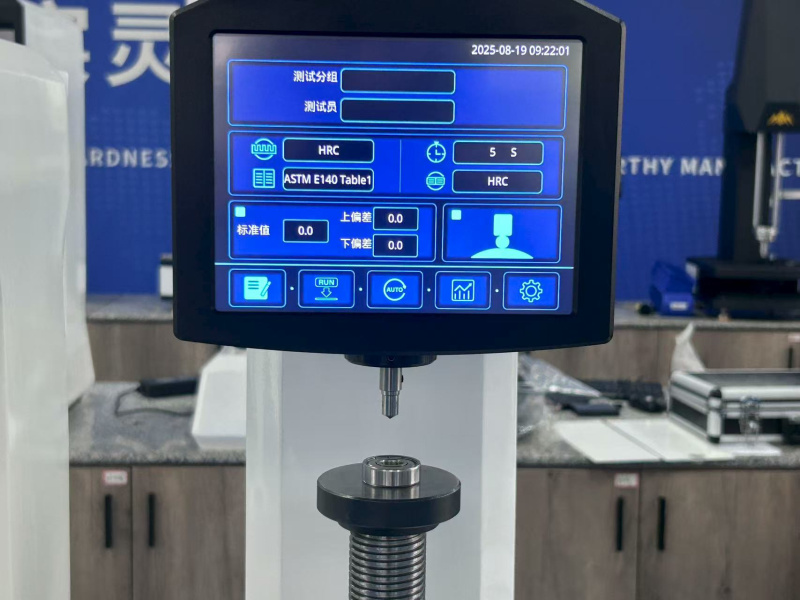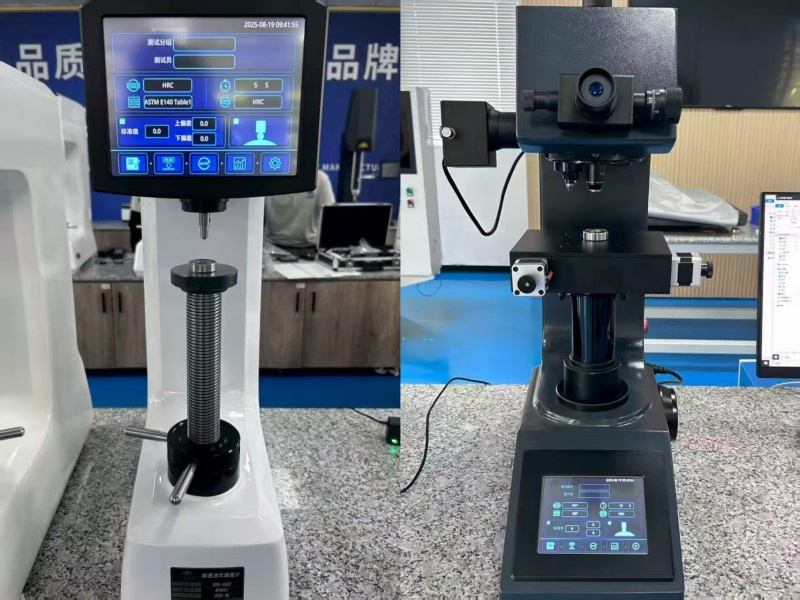
Rolling bearings are core components widely used in mechanical engineering, and their performance directly affects the operational reliability of the entire machine. The hardness testing of rolling bearing parts is one of the indicators to ensure the performance and safety. The International Standards ISO 6508-1″Test Methods for Hardness of Rolling Bearing Parts” specifies the technical requirements for part hardness testing, including the following contents:
1.Hardness requirements for bearing parts after tempering;
1)High-carbon chromium bearing steel (GCr15 series):
The hardness after tempering is usually required to be in the range of 60~65 HRC (Rockwell hardness C scale);
The minimum hardness should not be lower than 60 HRC; otherwise, the wear resistance will be insufficient, leading to early wear;
The maximum hardness should not exceed 65 HRC to avoid excessive brittleness of the material, which may cause fracture under impact load.
2)Materials for special working conditions (such as carburized bearing steel, high-temperature bearing steel):
Carburized bearing steel (such as 20CrNiMo): The hardness of the carburized layer after tempering is generally 58~63 HRC, and the core hardness is relatively low (25~40 HRC), which balances surface wear resistance and core toughness;
High-temperature bearing steel (such as Cr4Mo4V): After tempering in a high-temperature environment, the hardness usually remains at 58~63 HRC to meet the wear resistance requirements at high temperatures.
2.Hardness requirements for bearing parts after high-temperature tempering;
200°C Raceway 60 – 63HRC Steel Ball62 – 66HRC Roller61 – 65 HRC
225°C Raceway 59 – 62HRC Steel Ball62 – 66HRC Roller61 – 65 HRC
250°C Raceway 58 – 62HRC Steel Ball58 – 62HRC Roller58 – 62 HRC
300°C Raceway 55 – 59HRC Steel Ball56 – 59HRC Roller55 – 59 HRC

3.Basic requirements for the tested samples in hardness testing, as well as various testing specifications such as the selection of hardness testing methods, test force, and test position.
1)Test forces for Rockwell hardness tester: 60kg,100kg,150kg(588.4N, 980.7N, 1471N)
The test force range of Vickers hardness tester is extremely wide:10g~100kg (0.098N ~ 980.7N)
Test force for Leeb hardness tester: Type D is the most widely used specification for test force (impact energy), suitable for most conventional metal parts
2)See the figure below for the testing method
|
Serial No. |
Part specification |
Test method |
Remarks |
| 1 | D< 200 | HRA,HRC | Priority is given to HRC |
| bₑ≥1.5 | |||
| Dw≥4.7625~60 | |||
| 2 | bₑ<1.5 | HV | Can be tested directly or after mounting |
| Dw<4.7625 | |||
| 3 | D ≥ 200 | HLD | All rolling bearing parts that cannot be tested for hardness on a benchtop hardness tester can be tested by the Leeb method |
| bₑ ≥ 10 | |||
| Dw ≥ 60 | |||
| Note: If the user has special requirements for hardness test, other methods can be selected to test hardness. | |||
|
Serial No. |
Test method |
Part specification/mm |
Test force/N |
| 1 | HRC | bₑ ≥ 2.0, Dw ≥ 4.7625 | 1471.0 |
| 2 | HRA | bₑ > 1.5 ~ 2.0 | 588.4 |
| 3 | HV | bₑ > 1.2 ~ 1.5, Dw ≥ 2.0 ~ 4.7625 | 294.2 |
| 4 | HV | bₑ > 0.8 ~ 1.2, Dw ≥ 1 ~ 2 | 98.07 |
| 5 | HV | bₑ > 0.6 ~ 0.8, Dw ≥ 0.6 ~ 0.8 | 49.03 |
| 6 | HV | bₑ < 0.6, Dw < 0.6 | 9.8 |
| 7 | HLD | bₑ ≥ 10, Dw ≥ 60 | 0.011 J (Joule) |
Since its implementation in 2007, the test methods specified in the standard have been widely applied in the quality control of production process in bearing manufacturing enterprises.
Post time: Aug-20-2025







